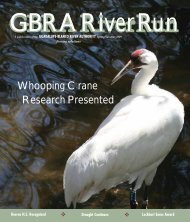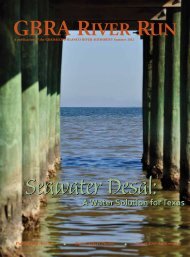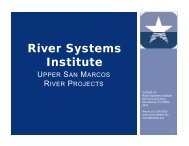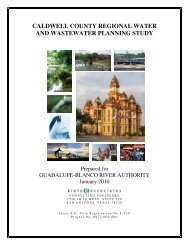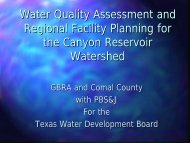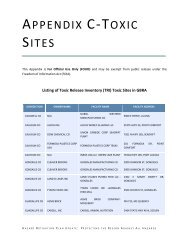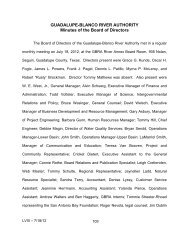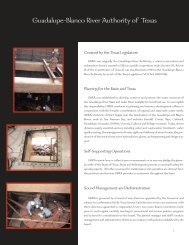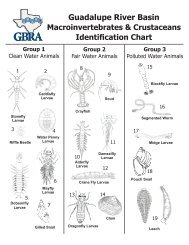Fall 2012 - Guadalupe-Blanco River Authority
Fall 2012 - Guadalupe-Blanco River Authority
Fall 2012 - Guadalupe-Blanco River Authority
You also want an ePaper? Increase the reach of your titles
YUMPU automatically turns print PDFs into web optimized ePapers that Google loves.
GBRA RIVER RUNA publication of the GUADALUPE-BLANCO RIVER AUTHORITY <strong>Fall</strong> <strong>2012</strong>EnoughWater?New E.D. for SABAY • Salt Water Barrier• E-Flows Planning
Field and OfficeA New Position and Promotions at GBRAThe <strong>Guadalupe</strong>-<strong>Blanco</strong> <strong>River</strong> <strong>Authority</strong> recently added a newposition and internally promoted several other employees.Patti Coggins joined GBRA in December as its grant writer/administrator, a newly created position organizationally locatedwithin the Officeof Communicationand Education.Coggins, whoearned her bachelorof science degreein human scienceand nutrition fromthe Universityof Mississippi,her master ofscience anddoctoral degreesin agriculture andfood science fromMississippi StateUniversity, worksfrom GBRA’s mainPatti CogginsPhotos by Janet Thomeoffice in Seguin.From 2003 to 2011, she was research director and director ofGarrison Sensory Evaluation Laboratory at Mississippi StateUniversity where her responsibilities included grant writing forfederal programs and initiatives in order to support the facility andpersonnel as well as managing multiple governmental grants.In her newposition, Cogginswill prepareproposals andgrant applications,research, identify,develop and procurefederal, state,local and privategrant and fundingopportunities inthe areas of civilinfrastructure,hydro-engineering,energy,environment,technologyand education.Leigh CrettendenAdditionally, she willassist the organization’s managers with developing, implementingand maintaining reporting requirements for such grants.“We are very excited to have Patti and look forward to drawingupon her extensive expertise in grant writing and administration,”LaMarriol Smith,chief strategiccommunicationsand public affairsofficer said, adding,“During her tenureat Mississippi StateUniversity, shegarnered morethan $14 millionthrough her grantwriting efforts.”GBRA alsorecently promotedwebmaster LeighCrettenden toInformationTechnologyManager, effective in January 2013. Crettenden, who started withGBRA in March 2006, will take over the IT reigns from AngelaWhitley, who is leaving after 15 years with GBRA, having started asa network administrator in November 1997.Other recent promotions include: Don Koble, who startedwith GBRA in November 1981. Koble was promoted from senioroperator at Calhoun Canal to chief operator at Calhoun Canal,effective in December; Jim Wyatt, who started with GBRA inFebruary 1980,was promotedfrom electricalinstrumentationtechnician to SCADAadministrator,effective inDecember; hydromaintenance crewmember DavidMaltony, whostarted with GBRAin April 1995,was promotedto the positionof purchasingand inventorycoordinator,effective inSeptember; andJim WyattDavid MaltonyKylie Gudgell, who started with GBRA in September 2008, waspromoted from laboratory technician III to laboratory analyst I,also effective in September.2GBRA <strong>River</strong> Run <strong>Fall</strong> <strong>2012</strong>
itCanoe RacePhotos by Julie MathewsUnlimited ClassHR:MIN:SEC1st John Baltzell 1:38:542nd Mark Simmons, Gary and Ashley Robinson, 1:45:55John Qualls, Pat Petrisky, Linden Welsh3rd Megan, Abigail, and Norianne Yeager, 2:07:38John BuggeUSCA C1 Class1st Joy Emshoff 2:19:342nd Ed Jones 2:21:143rd Richard Crow 2:37:06USCA C2 Class1st Jerry Nunnery, Eric Whicker 1:49:582nd Brian Jones, Vance Flores 1:59:433rd Mike Smith, Eddie DeLarosa 2:18:16Solo Unlimited Class1st Michael Rendon 1:44:052nd Gary Kohut 1:59:19Women’s Unlimited Class1st Erin Magee 1:54:082nd Brenda Jones 2:31:43Recreational Class1st Craig Woodman, Melanie Grabowske 4:03:00GBRA <strong>River</strong> Run <strong>Fall</strong> <strong>2012</strong> 5
DornakGets Active in Plum CreekIntroduced in the last issue of the GBRA <strong>River</strong> Run, NickDornak, the new watershed coordinator for Plum Creek, hasbeen busy with a variety of activities affecting the PlumCreek Watershed.For starters, Plum Creek watershed stakeholders are gettinga healthy dose of feral hog management education via the HogOut County Grants Program. The desire is to help prevent themore than $52 million in agricultural losses that feral hogs causeannually in the State of Texas. Feral hogs have also been identifiedas a potential source of E. coli found in Plum Creek which ismonitored extensively throughout the watershed. Through effortsof the Plum Creek Watershed Partnership, Hays and CaldwellCounty Commissioners, local businesses, volunteer groups andlandowners, more than 800 feral hogs were removed from thewatershed and more than 100 individuals received at least anhour of feral hog management training from October throughDecember <strong>2012</strong>.Dornak also has been working to provide financial andtechnical assistance to members of the Plum Creek WatershedPartnership, including cities, farmers and ranchers in the PlumCreek watershed. His efforts have included assisting in thepursuit of funds through the Clean Water State Revolving FundLoan Program administered by Texas Water Development Boardto address failing septic systems in Hays County, the CapitolArea Council of Governments Solid Waste Grant Program tofund community collection events in Caldwell County, andcoordinating countywide efforts for the Hog Out County GrantsProgram. He also has applied for a Clean Water Act, Section 319grant for the development of a Plum Creek Riparian Cooperativeto enhance stakeholder knowledge of riparian ecosystems andencourage participation in best management practices thathave been identified in the Plum Creek Watershed ProtectionPlan. Dornak served as co-coordinator for the 5th AnnualKeep Lockhart Beautiful, a Plum Creek Cleanup that brought300 volunteers together on Sept. 22, <strong>2012</strong> to clean several cityparks and waterways. Additionally, Dornak has given dozensof presentations to schools and organizations throughout thewatershed since taking on his position in March <strong>2012</strong>.Dornak, a Goliad, TX, native earned his bachelor of sciencedegree in Agricultural Development from Texas A&M Universityand his master of science degree in Rangeland Ecology andWatershed Management from the University of Wyoming.Photo by Liz SedlacekGM ModeratesWater ForumGBRA General Manager served as moderator forGreater Boerne Water Forum in September at theBoerne Convention and Community Center.Panelists participating in the forum included Rep.Doug Miller, Rep. Allen Ritter, Steve Clouse and EdVaughn. The theme of the forum was “Perspectivesfrom the State Capitol and Regional water Experts.”Photo by LaMarriol Smith6GBRA <strong>River</strong> Run <strong>Fall</strong> <strong>2012</strong>
Work Plan for the Texas Instream FlowProgram Progressesby Debbie MaginHow much water do Texas rivers and streams need? Inresponse to that question, Senate Bill 2 (SB2) was passed in2001. The legislation directed the state “to conduct studies andanalyses to determine appropriate methodologies for determiningflow conditions in the state’s rivers and streams necessary tosupport a sound ecological environment.” The agencies assignedthese tasks were the Texas Water Development Board (TWDB),the Texas Commission on Environmental Quality (TCEQ) and theTexas Parks and Wildlife Department (TPWD). In response to thedirectives in SB2 the three agencies developed the Texas InstreamFlow Program (TIFP). In 2005 the National Academies of Sciencereviewed the TIFP and found that it conforms to best scientificpractices and will provide “enormous benefits to the state.”Achieving the goal of the legislation to determine flows that willsupport healthy aquatic communities requires a multidisciplinaryapproach. The TIFP looks at water quality, hydrology andhydraulics, biology, connectivity to the riparian environment andthe physical processes at work in the streams. To maintain a soundecological environment within a stream requires not one flow buta “flow regime.” Flow components such as pulse flows that movedetritus, overbank flows that bring in nutrients, subsistence flowsthat can support the aquatic community during times of drought,along with base flows, are needed to provide a healthy aquaticenvironment. For each river basin or sub-basin, TIFP conducts sitespecific studies in order to determine flow-ecology relationshipsfor each of these flow regime components. Since 2007, studies areongoing in the Lower San Antonio and Middle and Lower Brazos<strong>River</strong> sub-basins.Over the next three years, the state agencies, along with GBRA,will conduct the TIFP study of the lower <strong>Guadalupe</strong> <strong>River</strong>. Thestudy process includes data collection and evaluation, both ofcurrent data measured in the streams as well as the historicaldata collected by other scientific efforts, such as the Clean<strong>River</strong>s Program and the U.S. Geologic Survey. Along the way,stakeholders in the <strong>Guadalupe</strong> <strong>River</strong> Basin will have multipleopportunities to help develop the goals of the study, review thefindings and inquire about what is being done on their river. Thefirst two public meetings will be held in January 2013. The processwill include peer review by other knowledgeablescientists that work in the fields of aquatic biology, hydrologyand geomorphology.The timing of the SB2 TIFP study of the lower <strong>Guadalupe</strong> <strong>River</strong>is right. In 2007, Senate Bill 3 (SB3) was passed and formallyestablished the Environmental Flow Allocation Process, a processto rapidly determine the amount of flow necessary to providefor a sound ecological environment in the streams and baysand estuaries.The SB3 process relied on the best available science tomake recommendations, but includes an adaptive managementprocess to refine environmental standards as additional studiesare completed or conditions change. The SB3 process forthe <strong>Guadalupe</strong>/San Antonio and Mission/Aransas <strong>River</strong>s wascompleted in <strong>2012</strong> and the stakeholders who representedindustries, municipalities, environmental interest groups, riverauthorities, agriculture and both commercial and recreationalfishing, have provided TCEQ with recommended flow regimes forboth instream and inflow into San Antonio Bay. The stakeholdersalso identified a work plan of studies and projects that are neededto reevaluate and adapt the flow needs as the basins change withtime. The top priority in that work plan is the completion of theTIFP study on the <strong>Guadalupe</strong> <strong>River</strong>.The TIFP on the lower <strong>Guadalupe</strong> <strong>River</strong> will get started in early2013, with several public meetings. Stakeholders will have theopportunity to help set the goals of the study. Preliminary workhas already begun to gather baseline fish data, sample sediments,evaluate riparian areas, and develop water quality models. Workhas already been completed to evaluate historical fish data fortrends, look at floodplain lake formation and dynamics, segmentthe river based on geomorphic characteristics, determine habitatrequirements of Golden Orb and review literature describingprevious work that has been completed in the basin, all of whichwill be used to develop an instream flow study design specific tothe Lower <strong>Guadalupe</strong> <strong>River</strong> Basin.GBRA <strong>River</strong> Run <strong>Fall</strong> <strong>2012</strong>7
2013 Texas Legisby Barbara Elmorefaces water drama8 GBRA <strong>River</strong> Run <strong>Fall</strong> <strong>2012</strong>Old West movies often depict leathery cowboyscrossing barren plains, hoarding water in their canteens fora long journey and scrapping for the last drop if the canteenfeels light.Today’s water battles bear a striking resemblance.Substitute vast numbers of people for the cowboys,shrinking reservoirs and aging pipes for the canteens, andthe picture facing Texas legislators as they convene in 2013comes into sharp, dry focus.Some lawmakers are writing a script that shows the stateinvesting unknown amounts to keep the water flowing.Republican House Speaker Joe Straus of San Antonio, for example,calls the need for legislative attention “critical” as he travels around the stateto talk up water. What form that attention will take is unknown, as a method forfunding projects does not yet exist and the battle ahead appears to be difficultand protracted.Complexities of waterTexas water issues are complex. Within the state’s vast borders, water supplies in someareas are robust, while others are near-crisis. Some areas have large reservoirs that enablethem to sell water to water-poor neighbors. Some municipalities depend on wells andimplement strict conservation measures when rainfall is low and the water table drops. Otherlocales ask for voluntary conservation.Competing budget interests—education, health care, transportation, immigration—also arevying for legislative attention.Complicating the water picture is the drought of 2011, which climatologists agree was theworst one-year drought since 1895. A 1954-1956 drought occurred too long ago for manypeople to remember, but state leaders’ actions to fix water problems afterward, such asconstruction of reservoirs, were responsible for a healthy water supply that allowed the state
latureof epic proportionsto grow into an economic and agricultural force. The increasingpopulation that star status attracts is a problem, however,especially when combined with the 2011 drought, which cost$7.62 billion in agriculture losses alone.“The drought last year—even though we are climbing out ofit—the severity of it has a lot of people’s attention,” CarolynBrittin of the Texas Water Development Board, said recently. “Theeconomic engine of the state is also paying attention.”The TWDB manages the state’s water planning process andoffers financial assistance programs to help fund projects. Brittinis its deputy executive administrator.The economicengine shementionedincludesother statescompeting forindustry bycomparing their plentiful water supplies with Texas’ diminishedreservoirs. “People understand the problem—verification iscoming from other states around the country,” said Rep. DougMiller, R-New Braunfels. The state of Wisconsin, which has wateraplenty, airs advertisements showing its brimming lakes side-bysidewith Texas’ Lake Medina, which is only 13 percent full.“They say, ‘Do you want to go to Texas?’ It’s an economic,competitive factor.”These are the backdrops for the drama that Texas legislators willbe starring in come January.Setting the state legislature’s tableAlthough the issue is as big and diverse as the Lone Star State,water planners on the regional level have offered legislators acourse of action. It is called the <strong>2012</strong> State Water Plan, and itsintroduction is blunt: “In serious drought conditions, Texas doesnot and will not have enough water to meet the needs of itspeople, its businesses, and its agricultural enterprises.” It thenoffers conservation and water management strategies necessary tomeet needs.Taken as a whole, the water plan’s price tag is a steep$53 billion dollars. Although the cost complicates discussions,the TWDB isIn serious drought conditions, Texas does not and willnot have enough water to meet the needs of its people,its businesses, and its agricultural enterprises.making proposalsto the legislaturethat requiresmaller amountsof financing.The TWDB wascreated after the 1954-1956 Texas drought with a mandate to planfor the state’s water supply. In 1997, after another drought, Texaschanged its method of water planning. The legislature created abottom-up process, where 16 state groups make decisions aboutregional water needs. The last three state water plans are productsof this process.However, all planning stops at the plans because the state hasbalked at the expense and because of the philosophy of somelegislators against incurring more debt. Every legislative proposalto finance water projects has failed thus far. For example, a tap feeGBRA <strong>River</strong> Run <strong>Fall</strong> <strong>2012</strong>9
Water Drama of Epic Propthat originated in the House years ago, which would have chargedhome and business owners annual fees for water, never got out ofthe House, said Rep. Allan Ritter, R-Nederland, chair of the HouseNatural Resources Committee, speaking at a public water forumhosted by the Texas Tribune, a nonprofit media organization.Now planners and legislators are pinning their hopes on the2013 legislative session to tackle some of the $53 billion inprojects in the <strong>2012</strong> Water Plan. “Regional entities are asking forabout $27 billion in assistance,” Brittin said. She stresses thatno one is asking for the state to pay for $27 billion in projects.“They are asking for interest subsidies for which the local entitieswould pay back the whole ofthe capital and most of theinterest.”Projects requiring TWDBhelp sometimes work this way:A city, county, or river authorityunable to absorb the full debt of a project may apply for waterproject funds through a State Participation Program. This programgives the TWDB temporary ownership interest in the projectby assuming most of the debt. TWDB must obtain legislativeapproval before issuing the bonds. If a project is approved, theentities move ahead and repay the debt on a deferred timetable,The TWDB has approved a $4.4 million loan for a GBRAfeasibility study to identify surface and groundwater supplies andtransmission delivery options. That proposal awaits legislativeapproval before going forward.Population pressures and fundingThe <strong>2012</strong> State Water Plan noted that the population of Texasincreased more than 20 percent between 2000 and 2010. Thatgrowth was not distributed evenly. For example, although some ofthe state’s 254 counties have less population now than they did in2000, others have grown more than 80 percent.Sudden growth isa challenge for anyentity that serves thepublic. Because almost55 percent of Texansrely on groundwaterfor drinking, droughtslike the last one are a big concern, especially since the droughtcontinues to affect the largest population areas even today. Forexample, the Edwards Aquifer, which comprises about 95 percentof San Antonio’s drinking water, fell to a level at its J-17 well ofabout 648 feet in mid-November <strong>2012</strong>. The long-term averageelevation of J-17 is 664 feet.But we cannot solve this problem withconservation only or reallocation ofagriculture supplies to municipal areas.and no project has ever defaulted on its state-backed loan. Thelast funding the legislature appropriated and authorized for StateParticipation was $225,050,000 in 2010-2011.A recent big project to use the State Participation Program wasa 101-mile pipeline built right after the 1996 drought and openedin 1998. It is called the Mary Rhodes Pipeline and it delivers waterfrom Lake Texana near Edna to Corpus Christi, which is the largestcustomer for the water. The project brought together the federaland state governments to finance construction. It cost $127million, and the TWDB still has $47,800,000 loans outstanding tothe Lavaca-Navidad <strong>River</strong> <strong>Authority</strong>.One of the projects the <strong>Guadalupe</strong>-<strong>Blanco</strong> <strong>River</strong> <strong>Authority</strong> ishoping will move onto the legislative table in 2013 is its Mid-BasinProject, which would provide water for a growing populationin Hays, Caldwell, Comal, <strong>Guadalupe</strong> and Kendall counties. Thecapital cost would be $547 million, but people who use the waterwould pay off the loan when water supplies go online.Although lawmakers have not yet reached consensus on howto pay for water or even what the state’s role should be, theydid put Proposition 2 before voters in November 2011. Votersapproved it, allowing the TWDB to issue additional bonds for waterimprovements as long as no more than $6 billion are outstandingat any one time.Legislators need to discuss what the approval of Proposition 2means for future water projects, said William E. West, Jr., generalmanager of the GBRA. “They need to talk about how many projectsin the plan qualify for Proposition 2. Some legislators believethat only those projects with immediate payback and nothing atrisk should be funded.” That philosophy poses an equityproblem for some parts of the state, he noted. Big cities withdense population can finance projects on their own, while ruralareas cannot.10 GBRA <strong>River</strong> Run <strong>Fall</strong> <strong>2012</strong>
ortionsWhat might happenSen.Glenn Hegar, R-Katy, who has been on the Senate Natural Resources Committee for six years,said the drought of 2011 brings a heightened realization of an ever-increasing need for water andwater infrastructure. He also noted that legislators do not have to deal with the $53 billion total inthe water plan all at once. “But we must get started on funding it,” he said.The question is how to get everyone to agree on a funding mechanism. Both Hegar andMiller mention the state’s $8.1 billion rainy day fund, formally known as the EconomicStabilization Fund.“I believe we have been blessed with an increasing rainy day fund that wewould be wise to use for infrastructure funding for water and for transportation,”Hegar said. “That’s not the sole solution—that is just to begin to get us moving inthat direction.”Hegar, who once grew rice on his farm north of Katy, now grows only drylandcrops. The farm gives him insight into state water needs that some of hisurban colleagues may not have. “We all like to eat, and food has to comefrom somewhere. It’s much better to have a strong and stable foodsupply within our country than outside of it. And agriculture is a majoreconomic driver for the state.”Conservation is important too, he noted, adding that battlesstill exist between urban areas and agricultural regions. A winlosewater plan, where a city wins at the price of a rural area,or vice-versa, makes everyone losers in the end, he adds.Miller, a four-year member of the House Natural Resources Committee, said he hopes for enough“residual memory” of the 2011 drought to allow for legislation that will develop a funding streaminstead of a one-time appropriation. He also sees a connection between water and electricity. “Thereis a great nexus between those two; in the production of power, you need water. In the end use ofelectricity, you will be using water. Texans can’t do without either, and tying those two together is alogical avenue to research.”If the problem is not fixed, leaders warned that the economic engine of Texas will stall. “We knowthe state has big issues of balancing the budget, and there is health care and education,” West said.“But we cannot solve this problem with conservation only or reallocation of agriculture supplies tomunicipal areas. “The powers that be recognize the need for the state to step up, but what does thatmean? What components of the water plan warrant the state’s assistance? All special efforts to raisemoney so far have failed.”Still, he remains optimistic that some projects will be approved. “What that funding is, what isthe mechanism, and how many projects, is the focus. We need visionary projects, because all theeasy ones have been done. With a legislature that meets only every two years, we need actionthis session.”GBRA <strong>River</strong> GBRA Run <strong>River</strong> <strong>Fall</strong> Run <strong>2012</strong> <strong>Fall</strong> <strong>2012</strong>11
Hold the saltby Barbara ElmoreDrought requires return of rarely seen barrier on <strong>Guadalupe</strong> <strong>River</strong>Photo by Charlie HickmanA barrier that once was a rare sight at the confluence of the<strong>Guadalupe</strong> and San Antonio rivers near the tiny South Texascommunity of Tivoli has appeared with more frequency since2009—one more result of the historic drought that has grippedthe state.To picture the barrier, imagine two banana-shaped balloons inthe river, side-by-side, made of heavy-duty rubber like the tires ona car. Although boaters and landowners might do a double-take atthe sight, those who depend on the <strong>Guadalupe</strong> <strong>River</strong> for drinking,irrigation, aquaculture, business, or other purposes can takecomfort knowing that the odd-looking structure is protecting freshwater from the corrosive salt water of San Antonio Bay.Although the barrier is more than 45 years old, people oftenforget about it because of its less-than-constant presence. Whennot in use, it sits on the river bed, deflated. During times of normalor high river flow, it could sit idle for months or years.Landowners and boaters have spotted it more often lately as lowriver flow requires its presence to raise the river above sea level tokeep higher seawater from creeping into lower river water.“Salt water intrusion into the <strong>Guadalupe</strong> is rare,” said HerbWittliff, plant manager at GBRA’s Port Lavaca Water TreatmentPlant. “<strong>River</strong> flows have to get down to zilch for salt water toinvade the river.” However, low flows occurred often in 2009,2011, and <strong>2012</strong>.GBRA, which holds senior water rights in the area, built theLower <strong>Guadalupe</strong> Diversion Dam and Salt Water Barrier in 1965to maintain fresh water supplies after the severe drought of the1950s. The balloons, originally made by tire maker Firestone with areplacement made by Bridgestone, have performed perfectly overthe years, Wittliff said, allowing GBRA to ensure good water qualityfor the City of Port Lavaca and other users.The balloons’ permanent home is the floor of the <strong>Guadalupe</strong><strong>River</strong> about 10 miles upstream from its mouth at San AntonioBay. During times of average rainfall, when the river is percolating,they are out of sight to anything but fish. But when the riverelevation drops, the barrier rises to elevate the <strong>Guadalupe</strong>between 1 to 2 feet at the point of diversion to keep it abovebrackish San Antonio Bay.12GBRA <strong>River</strong> Run <strong>Fall</strong> <strong>2012</strong>
Photo by Charlie HickmanPhotos by Bryan SeroldWittliff emphasized the amount—about a foot and a half ofwater—because some landowners believe the barrier isresponsible for river flooding on their land. The criticism isunfounded, said Wittliff and Bryan Serold, operations manager forGBRA’s Lower Basin.“It’s important that we are talking about a foot and a half,” saidWittliff. “During flood times, the barrier is inoperative, and in timesof low flow, there is no flooding of land.” GBRA diverts a smallamount of water when the river rises, but most of the river watercontinues on a path to the bay.The <strong>Guadalupe</strong> does indeed overflow its banks during times ofheavy rainfall, inundating land that Serold called “as flat as a pooltable.” That’s nature taking its course, however. “When the river ishigh enough to flood, there are natural cuts where it flows acrossthe country,” Serold said. During flooding, the barrier bags areout of the picture. Nor does the middle support cause water tooverflow, he added, because water flows over it.The massive structure draws attention both because of itssporadic appearance and its size. Most of the barrier, whichmeasures 10 feet in diameter and 50 feet in length, is underwater.The center bulkhead provides support, with the force of the damconcentrated there. This pier is essential to successful operation."Without it, the span would be too wide for the bags to do theirjob," said Wittliff.“When we want to activate the bags, we pump water out of theriver into the bags and they swell up and create the dam. If thebarriers are up and the river floods, they deflate.”Because of boating and other river pursuits, GBRA workerstry to alert people when they inflate the barrier. “Some years youforget it’s there,” Wittliff said. “When it comes back into operation,we issue a press release.”Even during drought, the barrier helps keep the taps open forwater customers, including 15,000 people in Calhoun County. TheCity of Port Lavaca, which relied on deteriorating groundwaterbefore GBRA stepped in, would not have a secure water sourceotherwise, Wittliff said. “If we got into a drought like the 1950s, wecould not supply them water without the barrier.”GBRA <strong>River</strong> Run <strong>Fall</strong> <strong>2012</strong>13
The TrustPartnership Delivers Information toStreamside Landownersby Steve Jestervegetation and landform influences how these areas function onthe landscape. The workshops stress understanding andconcepts as opposed to proposing specific management practicesor recommendations.The GBR Trust is committed to continuing this series ofworkshops, in partnership with SWCDs or other resourcemanagement organizations, over the next twelve to eighteenmonths. The workshops are free to attendees and include aclassroom session, lunch and a field trip to a streamside area.Check the GBR Trust website or contact the GBR Trust at 830-379-5822 to learn more.Photo by Janet ThomeThe <strong>Guadalupe</strong>-<strong>Blanco</strong> <strong>River</strong> Trust has been working to developrelationships with local soil and water conservation districts(SWCD) in the middle and lower <strong>Guadalupe</strong> <strong>River</strong> basin over thelast eight months with the specific goal of cooperatively deliveringriparian zone function information to streamside landowners.SWCDs are locally governed, landowner operated subdivisionsof state government typically organized along county lines withthe mission to create interest and action in the application of soiland water conservation and resource management and to provideleadership in the conservation field to citizens of the District. Thismission is in close alignment with the mission of the GBR Trust,which is to preserve the unique natural heritage of the <strong>Guadalupe</strong>watershed for future generations, by protecting open landscapes,working farms and ranches, and wildlife habitat throughconservation easements, education, and outreach that connectspeople to the water and the land.The GBR Trust has met with the local governing boards of fivesoil and water conservation districts so far and is seeking to meetwith several more over the next few months in the middle andlower basin. These locally elected boards have been receptiveto the idea of forming partnerships to deliver information tostreamside landowners, and so far three workshops have beenheld. While the effort is taking a break over the winter, severalmore workshops are in the planning stage for spring 2013.Additionally, the GBR Trust was asked to present informationon the organization to two SWCD award banquets in Octoberwhere 75-80 local landowners and conservation leaders were inattendance. For a number of the attendees these events served asan introduction to the GBR Trust and its mission.The riparian workshops have also been well received byattending landowners and resource agency staff. While manylandowners have creek or river frontage that is very important tothem, many were hearing for the first time how the soil, water,How Does the Trust Work?The <strong>Guadalupe</strong>-<strong>Blanco</strong> <strong>River</strong> Trust works to accomplishits conservation mission in the following ways.• Land Conservation – The GBR Trust holdsconservation easements which are voluntaryrestrictions on development and subdivision that alandowner can place on their property deed to conserveworking farms and ranches, important wildlife habitatand open space. Conservation easement donors mayalso qualify for certain income tax advantages. The GBRTrust also owns a small amount of property outright.Its current portfolio of conserved land includes 9,400acres of conservation easements and 800 acres ofowned land.• Landowner Outreach –The GBR Trust conductslandowner outreach within the basin to deliverinformation on conservation tools and techniquesas well as providing information on other topics ofconservation concern. The GBR Trust typically interactswith several hundred people each year throughpresentations, meetings, workshops and other events.• Partnerships – The GBR Trust is also engaged witha number of local, regional, statewide and nationalconservation partners to work together on conservationprojects including land restoration, land conservationand outreach. Partners include both public agenciesand other nonprofit organizations such as DucksUnlimited. These partnerships range from informalworking relationships to formal, signed agreements.14GBRA <strong>River</strong> Run <strong>Fall</strong> <strong>2012</strong>
Inside GBRAwhere are they now?Charles DurstDurst remembers “spilling water” whileon the night shift at Lake McQueeney. Hewas working the shift alone, as crewmenusually do, when he heard the familiarrushing of the river outside, flowingfuriously over the dam. But this time aloud crash followed. It made Durst jump,but he told himself it was just a travelinglog caught up against the side of the dam.He then remembers a story he was toldabout the ghost of a man that travels theriver at night.Today, Durst smiles and says the ghoststories about things that went bump in the night at the hydro lakeswere passed between new and old crewmen, and probably are stillin circulation today.Durst was hired as a hydro crewman in 1981 for GBRA. He wastold he would work 12-hour shifts, need to know how to swim,learn to “spill” water, perform maintenance at the hydroelectricdams built in the 1930s, and operate spill gates in all types ofweather imaginable.“Some people think this is an easy job, but not just anybody cando it,” said Durst. “You have to have a strong mind to ‘spill’ waterfor 12 hours a day.”He also admits that hydro work can be difficult and hazardous,especially during a flood when lake capacities double or eventriple, and large objects such as boats and tree trunks travelbetween the lakes and over the dams.The GBRA Board of Directors met in a regular monthlymeeting Oct. 17, <strong>2012</strong>, at the Boerne Convention and CommunityCenter in Kendall County, Texas. Michael D. Schultz, Mayor ofthe City of Boerne offered a welcome and a number of otherlocal officials attended the meeting, including, Cheryl Landman,Mayor of the City of Fair Oaks Ranch; Jeff Haberstroh, a City ofBoerne councilman and Kathy Sanford, a City of Fredericksburgcouncilwoman.During the board meeting, constituents heard a presentationrelated to GBRA’s educational programs, partnerships andinitiatives, a discussion about the feasibility of a power anddesalinated water project, and a discussion about a memorandumof understanding between GBRA, UGRA, Kendall County, KerrCounty, Kendall County Water Control and Improvement DistrictNo. 1, Headwaters Groundwater Conservation District, and CowCreek Groundwater Conservation District to conduct a water“I do not miss being at ‘the hole’especially when it was thundering andlightning,” Durst said. “The hole” wasthe post where crewmen manuallyoperated the dam gate valves to controlwater flow and was only a 3-foot by5-foot building, without heating or airconditioning. It was also the only thingthat separated the crewman on dutyfrom the fierce weather and river onlyyards away.Photo by Connie Rothe Durst retired in 2009 but keeps busydoing handy man work at his church,The Bethel Pentecostal, and for friends and family and at home.When Durst finds the time, he enjoys lake fishing. Durst, alongwith his wife, Marie, have raised three sons and a daughter, andthey have 10 grandchildren and four great grandchildren.Durst says he still does morning exercises he was required todo while employed at GBRA. “Old habits are hard to break,” saidDurst, now in his mid-60s. He admits he needs all the help he canget to keep up with his 8-year-old grandson.Charles DurstStarted at GBRA—1981Retired at GBRA—2009Phone—(830) 379-2641Board Holds Meeting in Kendall Countysupply study to assist in securing water supplies for the area andfinancial assistance from the state.Photo by LaMarriol SmithGBRA <strong>River</strong> Run <strong>Fall</strong> <strong>2012</strong>15
employeeanniversaries@gbraGBRA recognizes the following employees for their dedication of service. (These employees started with GBRAbetween the months of October and January.)October10/8/1973 Ronald Gosnell Canal RWSS 3910/22/1979 Herbert Wittliff Calhoun Canal 3310/11/1990 Elizabeth Sedlacek Water Resources 2210/10/1998 Dennis Walker Buda WWTP 1410/15/2001 Marella Dalme General 1110/1/2001 Barbara Gunn General 1110/20/2003 Jose Leal Lockhart WTP 910/25/2007 Annlee Drazkowski General 510/22/2011 Tommy Walenta San Marcos WTP 110/17/<strong>2012</strong> Elizabeth Aguilar General New HireJanuary1/28/1976 Bryan Serold Water Resources 371/11/1977 Rodney Voss Hydro 361/14/1980 Darel Ball Water Resources 331/14/1980 Mark Henneke Water Resources 331/31/1981 David Lundin Port Lavaca WTP 321/16/1981 Curtis Seiler Coleto Recreation 321/4/1983 Alan Schneider Coleto Reservoir 301/5/1987 Samuel Widmer Coleto Recreation 261/27/1988 Sara Vazquez Coleto Recreation 251/2/2008 Edwin Boettner Shadow Creek 51/21/2008 James Murphy Water Resources 51/4/2010 Steven Maricle Hydro 31/3/<strong>2012</strong> Bryan Bertelson San Marcos WTP 11/16/<strong>2012</strong> Toby Dennis Western Canyon WTP 11/16/<strong>2012</strong> Derek Schedlbauer Western Canyon WTP 11/6/1995 Sandra Terry General 181/27/2004 Steve Wallendorf San Marcos WTP 91/24/2005 Susan Hubbert General 81/2/2007 Sheryll Kisiah Canal RWSS 6November11/1/1976 Michael Gerdes RUD 3611/19/1979 Wilfred Korth Coleto Recreation 3311/10/1981 Don Koble Canal RWSS 3111/14/1983 Jason Lewis Coleto Recreation 2911/6/1995 Thomas McNeal RUD 1711/24/1997 Jeannine Herrmann General 1511/19/1997 Angela Whitley General 1511/8/1999 James Asbury General 1311/22/1999 Eric Mendez Lockhart WWTP 1311/20/2000 Robert Scott Hydro 1211/1/2007 Gynna Hernandez General 511/5/2008 John Moryl Canyon Hydro 411/21/2009 Fred Hernandez Shadow Creek 311/21/2011 Stuart Evans Regional Lab 1Photo GBRA archivesDecember12/25/1981 Roy Odom Hydro 3112/6/1983 Constance Rothe General 2912/28/1992 Dianne Fly Coleto Reservoir <strong>2012</strong>/10/1999 Jerry Sharp San Marcos WTP 1312/20/2000 Wallis Gudgell Hydro 1212/29/2000 James Medrano Hydro 12Michael GerdesPhoto by Tammy Beutnagel16GBRA <strong>River</strong> Run <strong>Fall</strong> <strong>2012</strong>
GBRA Training & LicensesDennis Walker of Buda attended the <strong>2012</strong> NFPA ElectricalSafety in the Workplace Compliant Class and Basic ElectricalTroubleshooting Class.Richard Gaona of Calhoun County attended the <strong>2012</strong> NFPAElectrical Safety in the Workplace Compliant Class and BasicElectrical Troubleshooting Class, and the Transportation WorkerIdentification Credential (TWIC) program.Jim Lumley of Calhoun County attended the TransportationWorker Identification Credential (TWIC) program.Bill Penney of Calhoun County attended the <strong>2012</strong> NFPA ElectricalSafety in the Workplace Compliant Class and Basic ElectricalTroubleshooting Class and the Transportation Worker IdentificationCredential (TWIC) program.Curtis Gosnell of Calhoun County attended the TransportationWorker Identification Credential (TWIC) program.Michael Tompkins of Calhoun County attended the <strong>2012</strong> NFPAElectrical Safety in the Workplace Compliant Class and BasicElectrical Troubleshooting Class and TWUA - Special Fabrications.Herb Wittliff of Calhoun County attended the TWUA GoldenCrescent Storm Water Prep and TWUA - Special Fabrications.Scott Kolbe of Canyon Hydro attended Coaching the Lift TruckOperator 2.Wilfred Korth, Jr., of Coleto Creek Recreation attended the TexasDept. of Agriculture Pesticide Applicator Continuing Education.Jason Lewis of Coleto Creek Recreation attended the Certified Parkand Recreation Professional and the Texas Dept. of AgriculturePesticide Applicator Continuing Education.Marlon McAdams of Coleto Creek Reservoir attended the <strong>2012</strong>NFPA Electrical Safety in the Workplace Compliant Class and BasicElectrical Troubleshooting Class.Alan Schneider of Coleto Creek Reservoir attended the Texas Dept.of Agriculture Pesticide Applicator Continuing Education.John Urban of Coleto Creek Reservoir attended the Texas Dept. ofAgriculture Pesticide Applicator Continuing Education.Barbara Gunn of General attended the SAHRMA Conference.Daphne Harder of General attended the SAHRMA Conference.Billy Imhoff of General attended Coaching the Lift TruckOperator 2.Yolanda Pierce of General attended How to Create and DeliverExceptional Powerpoint Presentations.Wallis Gudgell of Hydro attended Coaching the Lift TruckOperator 2.Juan Juarez of Hydro attended Coaching the Lift Truck Operator 2.Manual Lopez of Hydro attended Coaching the Lift TruckOperator 2.Richard Maxwell, Jr., of Hydro attended Coaching the Lift TruckOperator 2.Jeffrey McKee of Hydro attended the Lab ProfessionalsStakeholder Work Group.Clint Retzloff of Hydro attended Coaching the Lift TruckOperator 2.Charles Schnitz attended Coaching the Lift Truck Operator 2.Michael Schultze attended Coaching the Lift Truck Operator 2.Rodney Voss of Hydro attended Coaching the Lift TruckOperator 2.Kimberly Helmke attended the Texas Watershed Steward.Jennifer Sanchez attended the Texas Watershed Steward.David Garcia of Port Lavaca attended the <strong>2012</strong> NFPA ElectricalSafety in the Workplace Compliant Class and Basic ElectricalTroubleshooting Class.Joey Kisiah of Port Lavaca attended the TWUA Golden CrescentStorm Water Prep and TWUA - Special Fabrications.Ronnie Parenica of Port Lavaca attended the TWUA GoldenCrescent Storm Water Prep and TWUA - Special Fabrications.Stephanie Shelly of Port Lavaca attended Water Utility Safety andTWUA - Special Fabrications.Brian Lyssy of RUD attended TEEX - Basic Wastewater Operations.Ed Boettner of Shadow Creek attended the <strong>2012</strong> NFPA ElectricalSafety in the Workplace Compliant Class and Basic ElectricalTroubleshooting Class.Fred Hernandez of Shadow Creek attended the <strong>2012</strong> NFPAElectrical Safety in the Workplace Compliant Class and BasicElectrical Troubleshooting Class.Darel Ball of Water Resources attended the Public DrinkingWater Conference.Debbie Magin of Water Resources attended the DisasterManagement for Water and Wastewater Utilities.Elizabeth Sedlacek of Water Resources attended the TexasWatershed Steward program.Michael Urrutia of Water Resources attended the Public DrinkingWater Conference.Hunter Duncan of Western Canyon attended TEEX - CustomerService Inspector.Christopher Harder of Western Canyon attended the <strong>2012</strong> NFPAElectrical Safety in the Workplace Compliant Class and BasicElectrical Troubleshooting Class.Derek Schedlbauer of Western Canyon attended Surface WaterProduction II.GBRA <strong>River</strong> Run <strong>Fall</strong> <strong>2012</strong> 17
<strong>Guadalupe</strong>-<strong>Blanco</strong> <strong>River</strong> <strong>Authority</strong>933 E. Court St.Seguin, Texas 78155Change Service RequestedPRST STDU.S. POSTAGE PAIDAustin, TXPERMIT NO. 1153WWW.GBRA.ORGGen/GRR/<strong>Fall</strong> <strong>2012</strong>/Cap-5500Scan the QR code (left) with your cell phoneusing a barcode reader app to download orforward a link of this publication online toyour friends.Mark Your CalendarJan. 1, 2013New Year’s Day HolidayGBRA Offices ClosedJANOmni Austin Downtown, Austin, TXhttp://www.twca.org/meetings/other/2013-Water_Laws_Conference.pdfRegistration: (512) 472-7216FEBJan. 16, 2013GBRA Board Meeting<strong>River</strong> Annex Bldg., Seguin, TXhttp://www.gbra.org/board/meetings.aspxJan. 24−25, 20132013 TRWA/TWCA Water Law ConferenceFeb. 20, 2013GBRA Board Meeting<strong>River</strong> Annex Bldg., Seguin, TXhttp://www.gbra.org/board/meetings.aspxFeb. 25−28, 2013AMTA/AWWA 2013 Membrane TechnologyConference and ExpoHenry B. Gonzalez Convention Center, San Antonio, TXContact: (772) 463-0820Mar. 6−8, 2013TWCA Annual ConventionSheraton Austin Hotel, Austin, TXhttp://www.twca.org/meetings.htmlMARMar. 10−13, 2013AWWA Utility Management Conference Renaissance Phoenix Glendale Hotel, Glendale, AZContact: (800) 926-7337Mar. 20, 2013GBRA Board Meeting<strong>River</strong> Annex Bldg., Seguin, TXhttp://www.gbra.org/board/meetings.aspxMar. 29, 2013Good Friday HolidayGBRA Offices ClosedPhoto by LaMarriol Smith The <strong>Guadalupe</strong> <strong>River</strong>




